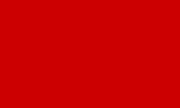Slovak Soviet Republic
| Slovenská republika rád (Slovak) Szlovák Tanácsköztársaság (Hungarian) |
|||||
| Slovak Soviet Republic | |||||
| 1919 | |||||
|
|||||
| Official language | Slovak , Hungarian | ||||
| Capital | Prešov | ||||
| Form of government | (Formal) Socialist Soviet Republic , puppet state of Hungary | ||||
| Head of state | Antonín Janoušek | ||||
| Head of government | Unknown | ||||
| founding | June 16, 1919 | ||||
| Proclamation of the Slovak Soviet Republic on June 16, 1919 in Prešov. | |||||
The Slovak Soviet Republic (Slovak: Slovenská republika rád , Hungarian: Szlovák Tanácsköztársaság ) was a communist puppet state in the east and south of today's Slovakia . It existed from June 16 to July 7, 1919 and was made possible by the advance of the Red Army of the Hungarian Soviet Republic under Béla Kun . The council government introduced paper money, which aroused distrust in the population. The authorities banned alcohol and expropriated larger properties. It came to an end during the advance of Czechoslovak troops in the Hungarian-Romanian War . It owned the third communist government in the world.
history
The defeat of the Central Powers in World War I led to the dissolution of the Austro-Hungarian Empire . The remaining Hungarian state suffered territorial losses from Czechoslovakia , which invaded Slovakia, from Romania, which got territories east of the line Satu Mare - Oradea - Arad , and from Serbia . The liberal government in Hungary collapsed and a communist system of rule under Béla Kun was set up to restore the old borders.
The invasion of Czechoslovakia took place in December 1918. At the end of April 1919, forays into Carpathian Ukraine and the Hungarian heartland began. The Red Army, under the command of Aurél Stromfeld , stopped the advance and began a counterattack on May 20, which threw back the Czechoslovak troops and led to the establishment of the Slovak Soviet Republic by the Czech journalist Antonín Janoušek. This interrupted the connection between the war partners Czechoslovakia and Romania and strengthened the communist position in Hungary.
An Entente peace agreement led to the withdrawal of Hungarian troops from Slovakia. Since the Romanian side demanded the demobilization of the Hungarian troops and the latter refused, the fighting resumed, which ended with the occupation and dissolution of the Slovak Soviet Republic. Janoušek was arrested by the local authorities in 1920 after the fall of the Hungarian Soviet Republic and later extradited to Czechoslovakia. He died in the Soviet Union in 1941.
terminology
Like its Hungarian counterpart , the Slovak Republic has the addition of councils instead of Soviet . The name Soviet republic was not adopted until 1922/23 with the establishment of the Soviet Union . At that time, both states no longer existed.
Individual evidence
- ^ Hannes Hofbauer , David X. Noack: Slovakia. The arduous way to the west. Promedia, Vienna 2012, ISBN 978-3-85371-349-5 , pp. 40–41.
- ↑ Gyula Juhász: Hungarian Foreign Policy 1919-1945. Akadémiai Kiadó, Budapest 1979, ISBN 963-05-1882-1 , p. 14 ff.

